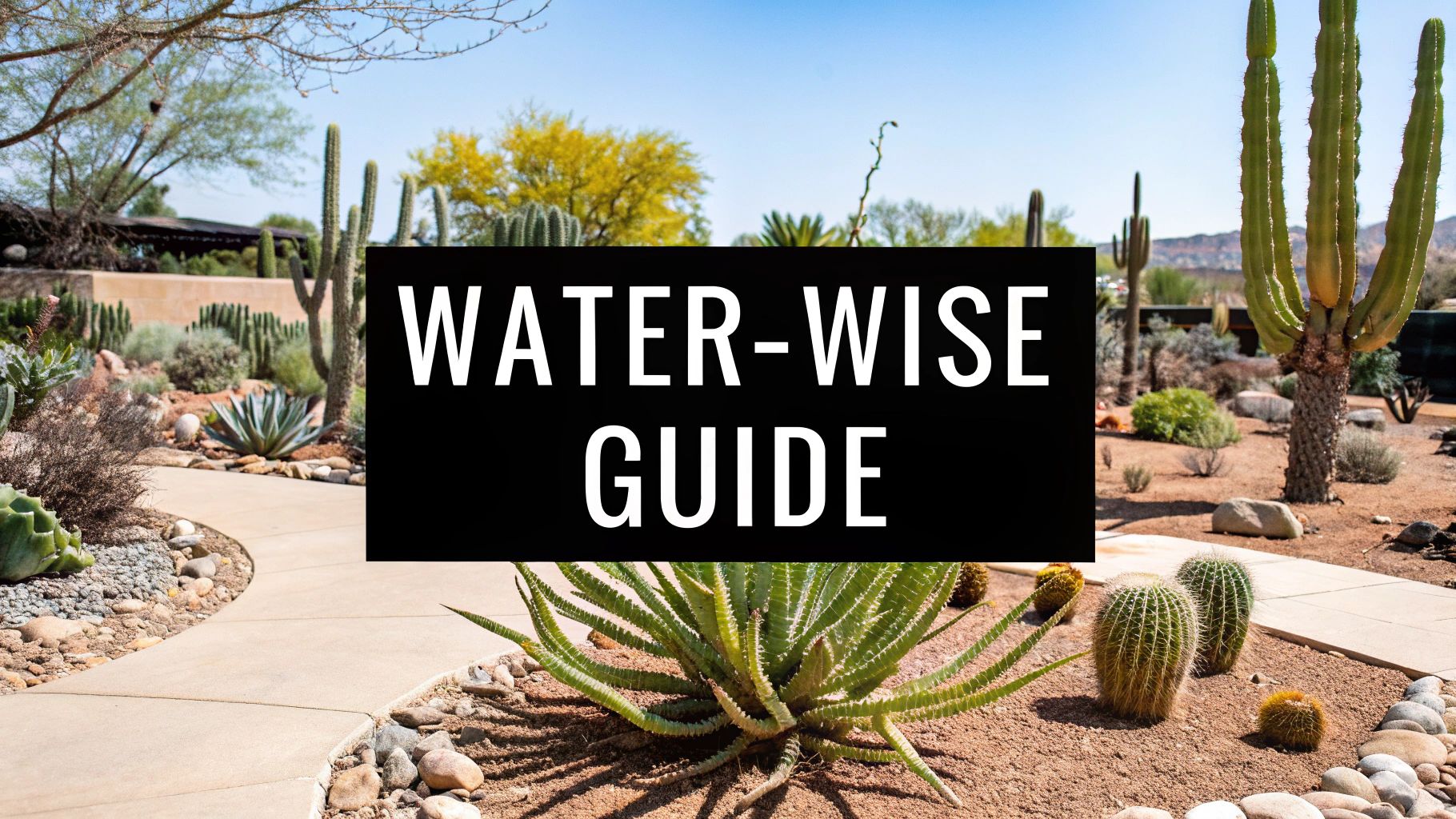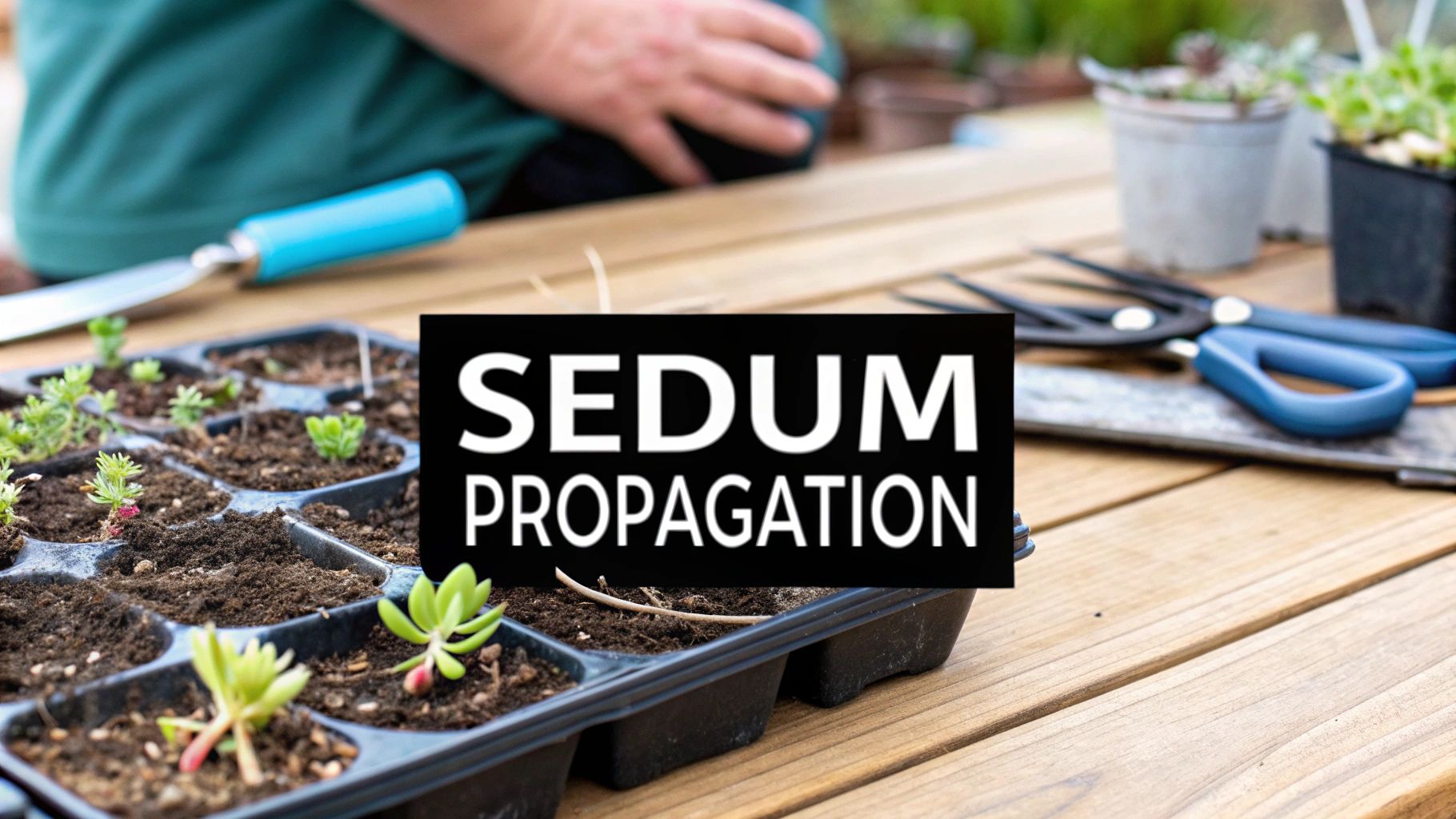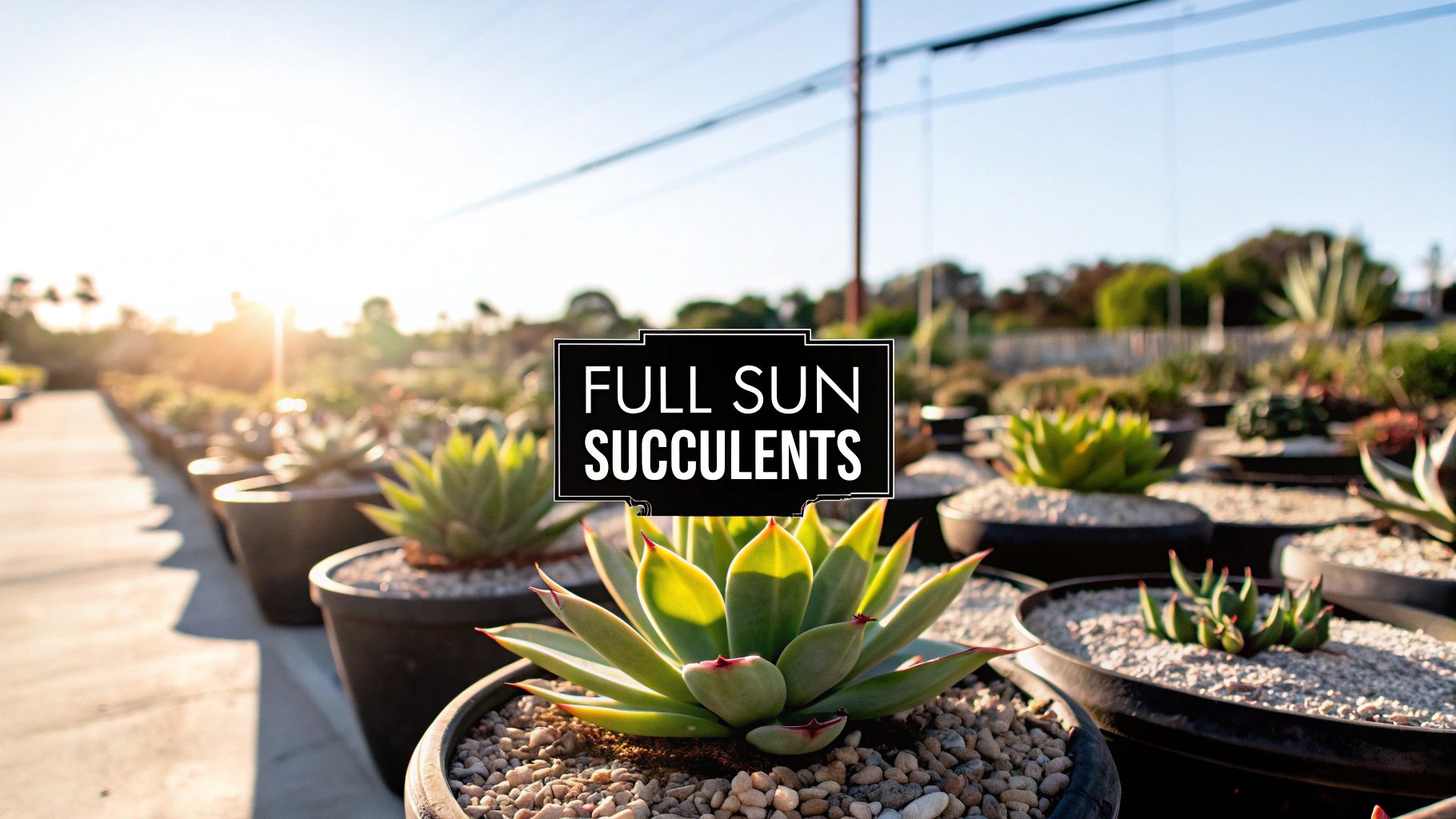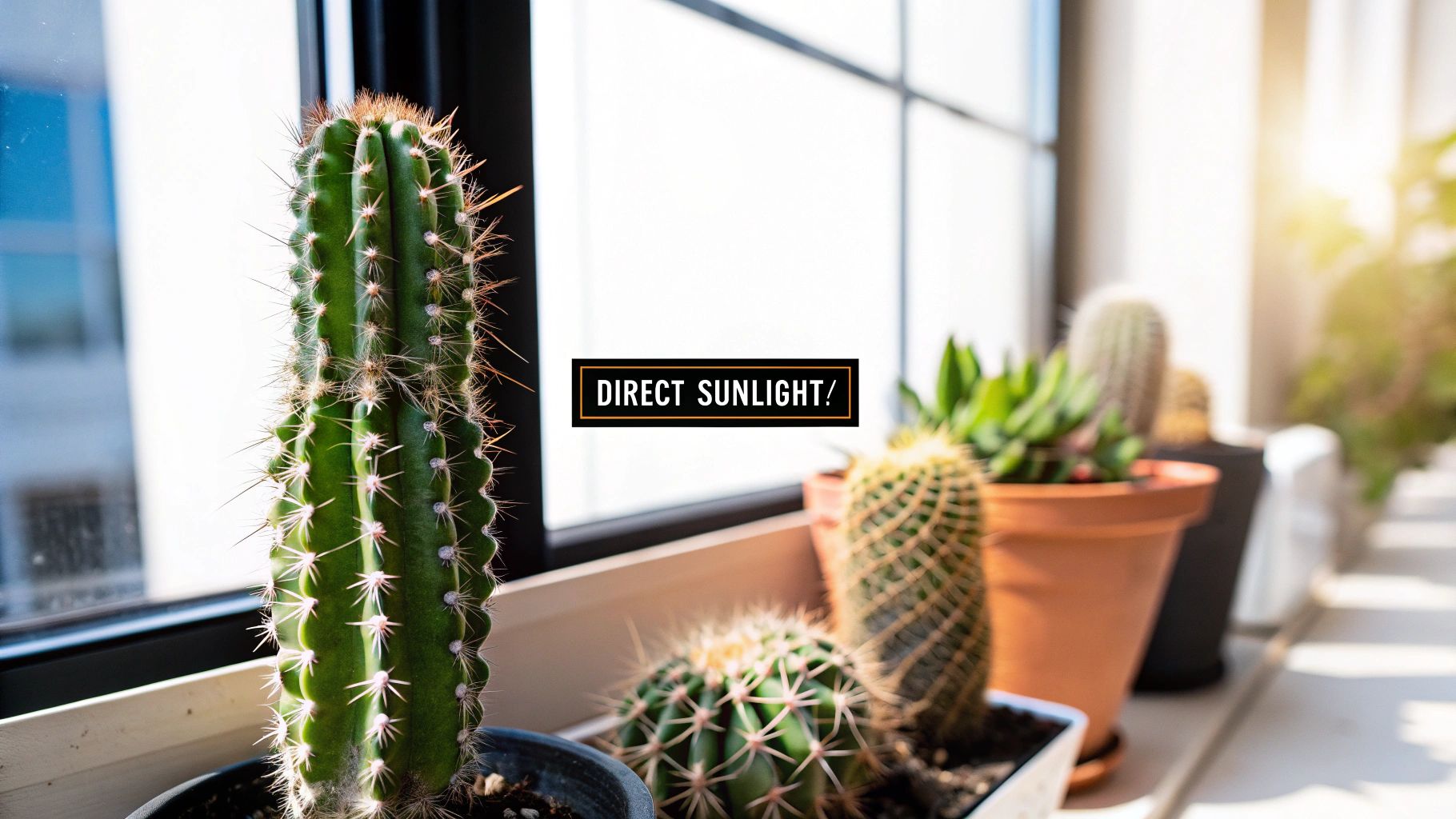Forget the image of a barren, rock-filled yard. A garden built with drought-tolerant plants is the secret to a vibrant, resilient outdoor space that actually asks for less from you—less water, less work, and less worry.
This isn't about sacrificing beauty for sustainability. It's about creating a lush, colorful landscape that’s smart, efficient, and perfectly in tune with its surroundings.
The Smart Choice for Modern Landscaping
When people hear "drought-tolerant," they often default to picturing a cactus and a tumbleweed. Let's bust that myth right now. This approach, known as xeriscaping, is all about crafting a stunning garden that's simply built to last.
Think of it as a long-term investment in your property. You get a beautiful yard that pays you back with lower water bills and more free time on the weekends. Instead of constantly battling your local climate with thirsty, high-maintenance plants, you'll be working with nature, not against it. By choosing species that are already adapted to dry spells, you build a landscape that doesn't just survive the summer heat—it thrives in it.
Why Water-Wise is the Way Forward
The decision to use drought-tolerant plants sends ripples far beyond your own fence. It's a meaningful way to build more sustainable communities, especially in areas where water is a precious commodity. You're directly helping to conserve a vital resource and support a healthier local ecosystem.
The numbers don't lie. Research consistently shows that a water-wise landscape can slash outdoor water use by 60% or more compared to a traditional lawn. In regions like California or the Mediterranean, that can mean a 30-50% drop in irrigation needs—a significant saving that supports a more sustainable future. You can learn more about the broader impact of drought-resistant crops from Global Market Insights.
The core idea is simple yet powerful: Create a garden that works with its environment, not against it. This shift in perspective unlocks a world of design possibilities that are both beautiful and responsible.
By embracing this method, you're not just planting a garden; you're cultivating a resilient outdoor sanctuary. You'll enjoy a space that remains beautiful and vibrant year-round, requiring less intervention and providing more enjoyment. It’s a landscape that is as practical as it is picturesque.
Here's a quick look at the main advantages of choosing drought-tolerant plants over high-water-use alternatives like traditional turf grass.
Key Benefits of Water-Wise Landscaping
| Benefit | Description | Long-Term Impact |
|---|---|---|
| Water Conservation | Uses significantly less water, often up to 60% less than traditional lawns. | Reduces strain on local water supplies and lowers utility bills. |
| Lower Maintenance | Requires less mowing, fertilizing, and overall upkeep once established. | Frees up your time and reduces ongoing yard work costs. |
| Enhanced Durability | Plants are naturally resilient to heat, drought, and regional pests. | Creates a garden that stays beautiful even in harsh conditions. |
| Ecosystem Support | Often includes native plants that provide food and shelter for local wildlife. | Promotes biodiversity and supports pollinators like bees and butterflies. |
Ultimately, choosing drought-tolerant plants gives you a beautiful, low-stress garden that's good for your wallet and even better for the planet.
How These Resilient Plants Survive and Thrive

Ever wonder how some plants look fantastic through a blazing summer while your lawn turns crunchy? The secret isn't magic; it's a collection of brilliant adaptations that help drought-tolerant plants not just get by, but actually thrive, when water is scarce. They’re the ultimate masters of water conservation.
Once you understand how these plants work, you'll have a much better feel for them. It also makes it a whole lot easier to pick the right ones that are already wired to handle your garden's specific conditions.
The Built-In Water Tanks
One of the most obvious survival tricks is their ability to store water. Succulents, like Agave and Aloe, are famous for this—they've evolved to hold onto every single drop they can absorb.
Think of a succulent's plump, fleshy leaves like a camel's hump. These unique tissues are essentially natural reservoirs, soaking up water during the rare downpour and storing it for later. This internal supply keeps the plant going strong through long dry spells when other plants would have already given up.
It's also why a firm, plump succulent is a happy one. It's a clear visual cue that its personal water tank is full and ready for whatever the weather has in store.
By storing water directly in their leaves, stems, or roots, these plants create their own emergency supply. This adaptation is a key reason why they require such infrequent watering once established.
Advanced Root Systems for Finding Water
What's happening underground is just as crucial as what you see on the surface. Drought-tolerant plants are pros at finding hidden moisture deep in the soil.
Many species, like Russian Sage or Coneflower, develop powerful taproots that tunnel straight down, sometimes several feet deep. They act like tiny well-drillers, pushing past the dry, sun-baked topsoil to tap into cooler, more reliable moisture below. It’s an exclusive water source that plants with shallow roots can only dream of.
Others take a different approach, growing a massive web of fibrous roots that spread out just under the surface. This network is incredibly efficient, designed to capture every bit of moisture from even the lightest shower before it has a chance to evaporate.
Clever Leaf Adaptations for Protection
A plant's leaves are usually where it loses the most water. To solve this problem, drought-tolerant species have come up with some incredible features to protect their foliage.
- Waxy Coatings: Take a close look at a succulent. That waxy layer, called a cuticle, acts like a waterproof seal. It locks moisture in and dramatically cuts down on evaporation, even under the most intense sun.
- Silvery or Fuzzy Leaves: Plants like Artemisia and Lamb's Ear sport fuzzy or silvery-grey leaves for a reason. These fine hairs and light colors are a natural sunscreen, reflecting harsh sunlight to keep the leaf surface cool and prevent water loss.
- Small or Needle-Like Leaves: Cacti and other desert natives took this idea to the extreme by shrinking their leaves into spines. Having a smaller surface area exposed to sun and wind is one of the most effective water-saving strategies out there.
Designing a Beautiful Water-Wise Garden

A garden filled with drought-tolerant plants isn't about making sacrifices—it's about smart, creative design. A truly successful water-wise garden is more than just a collection of tough plants; it's a carefully planned ecosystem where every element works in harmony. This process actually starts long before you ever pick up a shovel.
The secret to a resilient landscape is all in the prep work. When you take the time to map out your yard and really understand its quirks—where the sun hits, what the soil is like—you're laying the groundwork for a garden that doesn't just survive, it thrives with very little help from you. Think of this initial plan as your most important tool.
Group Plants by Their Water Needs
One of the smartest things you can do in a water-wise garden is hydrozoning. It sounds technical, but it’s a simple concept: group plants together that have similar watering needs. It's like seating guests with common interests at a dinner party—it just makes sense.
By putting any thirstier plants in one spot and your super drought-tolerant species in another, you can water each "zone" perfectly. This simple trick solves that classic problem of drowning a cactus just to keep a nearby flower happy. It's the cornerstone of efficient irrigation and makes your life a whole lot easier.
Hydrozoning is the key to creating a landscape that is both beautiful and highly efficient. By organizing your garden into distinct water-use zones, you can tailor your watering schedule precisely, saving water, time, and effort.
Prepare Your Soil for Success
Your soil is the lifeblood of your entire garden. When it’s healthy, it acts like a giant sponge, holding onto moisture and feeding it to your plants' roots long after the hose has been put away. The good news is that most native soils can be dramatically improved with a bit of attention.
Amending your soil with organic matter, like compost, is the single best thing you can do for your plants. Compost is amazing stuff; it helps heavy clay soils drain better and lets sandy soils hold more water. This one step creates a strong foundation that encourages plants to grow deep, healthy roots, making them much more resilient.
A well-prepped soil bed means you'll water less often and your plants will get established much faster. It's no wonder the demand for these kinds of plants is booming; the global market for drought-tolerant seeds was valued at USD 4.5 billion in 2023 and is projected to more than double by 2032.
Create Visual Interest with Texture and Form
Don't fall for the myth that water-wise gardens are boring or sparse. The truth is, drought-tolerant plants come in an incredible variety of textures, shapes, and colors that you can use to create a truly dynamic and visually stunning landscape.
The secret ingredient is contrast. Try playing with different forms to build a layered, captivating look.
- Combine Spiky and Soft: Pair the bold, architectural silhouette of an Agave with the soft, flowing blades of an ornamental grass.
- Mix Heights and Shapes: Use low, mounding plants like Lantana to set the stage for taller, upright species like Red Yucca.
- Vary Leaf Textures: Contrast the smooth, fleshy leaves of a succulent with the fine, almost feathery foliage of a plant like Artemisia.
This interplay between different textures adds a real sense of depth and sophistication. For even more great ideas on arranging these plants, take a look at our guide here: https://www.cactusoutlet.com/blogs/blog/succulent-garden-design-ideas
The Finishing Touch with Mulch
Finally, never, ever underestimate the power of mulch. Spreading a two- to three-inch layer of organic mulch, like wood chips, is like tucking your garden in with a protective blanket.
Mulch does a few crucial things: it insulates the soil, keeping it cooler in the summer, and it dramatically slows down evaporation from the surface. It also keeps weeds from sprouting and stealing precious water from your plants. Of course, if you'd rather leave the heavy lifting to the experts, considering professional landscaping services is always a great option for getting a beautiful outdoor space.
Our Top Picks for Drought-Tolerant Plants
Alright, you've got the design principles down. Now for the fun part: picking the plants.
If you're picturing a barren landscape of just rocks and a few lonely cacti, think again. The world of water-wise plants is bursting with incredible shapes, colors, and textures. This isn't just a shopping list; it's a gallery of possibilities meant to show you just how stunning a low-water garden can be.
I've broken down some of my personal favorites into categories. Think of these as the building blocks for creating a layered, visually interesting garden—from the structural shrubs that form the backbone to the vibrant succulents that steal the show.
Vibrant Succulents
Succulents are the undisputed stars of the water-wise world, and for good reason. Their fleshy, water-storing leaves come in an unbelievable range of colors and shapes, from tight, flower-like rosettes to cascading stems. They are perfect for tucking into rock gardens, spilling out of containers, or covering a patch of ground.
-
Echeveria: With its gorgeous, rose-like shape, an Echeveria is a total showstopper. These succulents form tight rosettes in shades of blue, green, pink, and even deep purple. Give them full sun to light shade and soil that drains quickly, and they'll reward you with sculptural beauty. They typically grow from just a few inches to over a foot across.
-
Sedum (Stonecrop): Sedums are the workhorses of the succulent family, offering everything from tall, stately varieties to low-growing groundcovers. ‘Autumn Joy’ is a classic upright type with big, pinkish-red flower heads, while something like ‘Dragon’s Blood’ will quickly form a dense, colorful mat. They’re incredibly hardy, don't mind poor soil, and absolutely love the sun, making them one of the most dependable plants you can find.
Architectural Cacti
When you want to make a bold, dramatic statement, nothing beats a cactus. Their sharp, geometric forms bring instant architectural flair to a garden. They're the ultimate symbols of resilience and, once they're settled in, they pretty much take care of themselves.
-
Barrel Cactus (Echinocactus grusonii): The Golden Barrel is iconic. Its classic round shape and bright yellow spines make it an amazing focal point, especially when you plant a few of different sizes together. It's a slow grower that demands full sun and perfect drainage to keep its roots from rotting. A mature one is truly a living sculpture.
-
Prickly Pear (Opuntia): Known for its flat, paddle-like stems, the Prickly Pear is all about unique form. Many varieties also produce beautiful flowers and even edible fruit. You can even find spineless types that are much friendlier in a garden setting. They thrive in heat and sun, growing into substantial shrubs that can double as a natural, prickly fence.
Colorful Flowering Perennials
Perennials are the gift that keeps on giving, returning year after year with reliable color and texture. You'd be surprised how many tough, beautiful bloomers can get by on very little water. Plus, they’re fantastic for attracting bees and butterflies, which brings a whole other layer of life to your garden.
-
Lavender (Lavandula): Silvery-gray foliage and fragrant purple flower spikes—what's not to love? Lavender is a classic for a reason. It craves full sun, prefers poor soil, and smells incredible. Once it's established, it's extremely drought-tolerant and puts on a beautiful show from late spring through summer.
-
Coneflower (Echinacea): With their distinct, shuttlecock-like blooms, Coneflowers are magnets for pollinators. The classic purple is lovely, but you can now find them in white, yellow, orange, and fiery red. They are tough, dependable flowers that handle heat and dry spells like champs, asking for little more than a sunny spot.
Hardy Foundational Shrubs
Shrubs are the "bones" of your landscape. They provide the essential structure, create backdrops, define different garden "rooms," and offer interest all year round. Many hardy shrubs are perfectly adapted to dry conditions, giving you foliage and flowers without being needy.
-
Russian Sage (Perovskia atriplicifolia): This plant creates a stunning, airy cloud of silvery foliage and lavender-blue flowers in the heat of late summer. It actually thrives on neglect, preferring full sun and dry, lean soil. Its wispy texture is a perfect counterpoint to the bold shapes of succulents and cacti.
-
Lantana: If you want a non-stop color factory, Lantana is your plant. This tough-as-nails shrub is covered in vibrant flower clusters from spring until the first frost, and butterflies absolutely adore it. It's incredibly tolerant of heat and drought, making it a go-to for those hot, sunny spots where nothing else seems to survive.
This image really drives home how different types of plants have different water needs—a crucial detail when you're planning your garden layout.

As you can see, while all these plants are water-wise, some, like native shrubs, can go the longest without a drink. That makes them perfect for anchoring the driest zones in your yard.
The secret to a great-looking landscape is layering. Mix the bold shapes of cacti, the soft textures of grasses, the solid structure of shrubs, and the vibrant colors of succulents and perennials. That's how you get a garden that is truly rich and full of visual interest.
Comparing Popular Drought-Tolerant Plant Types
Choosing the right plant for the right spot can feel overwhelming. This table breaks down the main categories to help you see at a glance what might work best for your specific needs.
| Plant Type | Example | Water Needs | Sunlight | Best Use Case |
|---|---|---|---|---|
| Succulent | Echeveria | Very Low | Full Sun / Part Shade | Containers, rock gardens, small spaces |
| Cactus | Barrel Cactus | Extremely Low | Full Sun | Focal points, sculptural accents |
| Perennial | Lavender | Low to Moderate | Full Sun | Borders, pollinator gardens, mass plantings |
| Shrub | Russian Sage | Low | Full Sun | Garden structure, backdrops, low-maintenance areas |
| Grass | Blue Fescue | Very Low | Full Sun | Groundcover, borders, adding soft texture |
Ultimately, the best gardens use a mix of these types to create a balanced, resilient, and beautiful space that works with nature, not against it.
Graceful Ornamental Grasses
You can't talk about texture without talking about ornamental grasses. They are essential for bringing movement and a soft, natural feel to a garden. They sway in the slightest breeze, their fine blades contrasting beautifully with bolder plants, and many are incredibly water-wise.
- Blue Fescue (Festuca glauca): This small, clumping grass is a favorite for its striking, powdery blue foliage. It forms neat, rounded mounds that look fantastic planted in large drifts or used as an accent in a rock garden. It holds its color all year and needs very little water once it settles in.
This push for resilient plants goes far beyond our backyards. Major research in agriculture is paving the way for more stress-tolerant crops, which is a huge deal for both food security and landscaping. For example, between 2014 and 2023, agricultural research in India developed over 7,200 new plant varieties, including 407 bred specifically to handle extreme conditions like drought. These efforts not only boosted crop yields but also gave us the blueprint for the tough, reliable plants we get to enjoy in our gardens. You can dive deeper into these agricultural breakthroughs in this report on drought-tolerant seeds.
Planting and Establishing Your New Garden

You’ve got the design and you’ve picked your plants—now for the fun part. The first few months after you put your plants in the ground are absolutely crucial. This is when your new garden is working hard to establish the deep, tough root systems that will see it through for years to come.
There’s a common misconception that drought-tolerant plants are tough from day one. The truth is, even the most resilient agave needs a little help settling in. Think of this stage as an investment. The care you put in now will pay you back with a stunning, low-maintenance landscape down the road.
Your main job here is to help your plants make a smooth transition from the cozy nursery pot to their permanent home in your yard, setting them up for a self-sufficient future.
The Best Time to Plant for Success
When you plant can make all the difference. While you can technically get away with planting year-round in many places, fall is often the sweet spot.
The air is cool, which puts less stress on the plants, but the soil is still warm. This combination is perfect for encouraging strong root growth. It gives your plants plenty of time to get established before the summer heat kicks in. Spring is a solid second choice, but you'll need to stay on top of watering as temperatures climb.
A Step-By-Step Planting Guide
Getting your plants in the ground correctly is about more than just digging a hole; it’s about creating the perfect environment for their roots to thrive.
- Dig the Right Hole: The golden rule here is to dig a hole that’s twice as wide as the plant's root ball but just as deep. This gives the roots room to spread out horizontally, which is key for stability and finding water.
- Check for Drainage: Before you do anything else, fill the empty hole with water. Watch how fast it drains. If the water is still sitting there after a few hours, you've got a drainage problem that needs fixing to prevent root rot. For specific tips, check out our guide on the best cactus and succulent soil.
- Position the Plant: Gently slide the plant out of its container and set it in the middle of the hole. Make sure the top of its root ball sits level with or even slightly above the surrounding soil.
- Backfill and Water In: Use the soil you originally dug out to fill the hole back in. You don’t need to add a bunch of rich compost right in the hole, as that can actually stop the roots from venturing out. Give it a good, long drink of water to settle everything and collapse any air pockets.
The single biggest mistake people make is planting too deep. Keeping the top of the root ball level with the soil line is absolutely critical for preventing rot and giving your plant a healthy start.
Training Your Plants to Be Tough
For the first growing season, you will need to water regularly. But the goal here isn't to pamper your plants—it's to train them.
The secret is to water deeply but infrequently. A thorough soaking every week or two encourages the roots to grow down, deep into the soil, searching for moisture. This builds the foundation for real drought tolerance. Watering a little bit every day does the exact opposite, creating a weak, needy root system that stays right at the surface.
This method essentially teaches your plants how to fend for themselves, which is how you get that tough, resilient oasis you've been planning.
Long-Term Care for a Thriving Landscape
Once your drought-tolerant plants are settled in, you get to enjoy the biggest payoff of this kind of landscaping: it's incredibly low-maintenance. The hard work is truly over. Now, it’s all about simple, seasonal check-ins to keep your garden healthy and beautiful.
This isn’t about a constant battle with chores. A water-wise garden gives you your weekends back. Your focus shifts from a demanding to-do list to just a few key tasks each season, ensuring your plants will flourish for years to come. The whole point is to create a self-sufficient landscape you can actually sit back and enjoy.
Mastering the Art of Maintenance
Long-term care for a drought-tolerant garden really boils down to a "less is more" mindset. Your main jobs will be occasional pruning, a bit of strategic watering during the most extreme heat, and keeping your mulch layer healthy. These simple steps go a long way in preventing problems and keeping everything looking sharp.
A little seasonal pruning is key for good plant health and shape. For your flowering perennials and shrubs, a light trim after they've finished blooming will encourage a flush of new growth and even more flowers next year. This also keeps plants like Russian Sage from getting too woody and leggy, so they stay a nice, full feature in your garden.
The single biggest mistake I see in established water-wise gardens is overwatering. These plants are adapted to dry conditions. Killing them with kindness—too much water—is the fastest way to cause root rot, which is the number one killer of drought-tolerant species.
Reading the Signs: Overwatering vs. Underwatering
Knowing when—and when not—to water is probably the most important skill you'll develop. An established plant will rarely need extra water from you, but a brutal, week-long heatwave might be the exception. The trick is to learn how to read the signals your plants are sending.
- Signs of Underwatering: The leaves might look a little limp, wilted, or start to curl in on themselves. This is just the plant's natural defense mechanism for conserving moisture.
- Signs of Overwatering: This is far more dangerous. You’ll see leaves turning yellow and mushy. The base of the plant might even feel soft and squishy, a classic sign that root rot is taking hold.
When in doubt, it’s always better to wait. If you're unsure, give it another day or two before you even think about grabbing the hose. For a more detailed look at what to watch for, our guide on how to water succulent plants has some great visual examples.
And don't forget the mulch! Topping up your mulch layer every spring is a fantastic way to help the soil hold onto moisture, which means you'll have to worry even less about supplemental watering.
Your Top Water-Wise Gardening Questions Answered
Diving into drought-tolerant landscaping is exciting, but it's natural to have a few questions before you start digging. Getting these sorted out from the beginning will give you the confidence to build a garden that not only looks great but also thrives with minimal effort. Let's tackle some of the most common questions we hear.
How Long Before My New Plants Can Handle a Drought?
This is probably the single most important thing to understand. For most drought-tolerant perennials, shrubs, and succulents, you're looking at one to two full growing seasons for them to get properly established. During this initial year or two, they’re going to need a bit more attention and more regular water than they will later on.
The trick during this phase is to water deeply but not too often. This approach encourages the roots to push down deep into the soil searching for moisture, which is exactly what trains them to be resilient for the long haul. Once they've built that robust root system, their water needs will drop dramatically, and they'll be able to handle dry spells with ease.
Are All Cacti and Succulents Drought-Tolerant?
It’s a great question, and the answer is almost, but not quite. While the vast majority of cacti and succulents are masters of water conservation, a few outliers come from jungle or tropical climates. Think of holiday cacti (Schlumbergera) or chain cacti (Rhipsalis)—these species actually prefer higher humidity and more consistent moisture.
But for the kind of dry-climate landscaping we're talking about, the classic choices are your best bet. These are the rockstars of the water-wise world:
- Agave
- Aloe
- Echeveria
- Most Barrel Cacti
It’s always a good idea to double-check the specific needs of any plant you bring home, but you can rely on these popular varieties to be true champions of a low-water garden.
There's a persistent myth that a water-wise garden has to be a bland mix of green and brown. Nothing could be further from the truth! With a little creative planning, you can create an explosion of color that also saves an incredible amount of water.
Can My Garden Still Be Colorful?
Absolutely! A drought-tolerant garden can be one of the most vibrant and colorful landscapes on the block. Many succulents, like Sedums and Echeverias, flush with brilliant shades of pink, purple, orange, and even near-black, especially when they get a bit of sun or temperature stress.
And don't forget about flowering perennials that attract bees and butterflies while adding spectacular blooms.
- Lavender offers its classic purple spikes and an unforgettable fragrance.
- Russian Sage brings a soft, airy cloud of lavender-blue flowers through the hottest parts of summer.
- Coneflower provides bold, cheerful blooms in a whole spectrum of colors.
When you start mixing these flowering plants with succulents and other foliage standouts—like the silvery leaves of Artemisia—you end up with a stunning, multi-layered garden that is as beautiful as it is sustainable.
Ready to start creating your own beautiful, resilient garden? At The Cactus Outlet, we have a huge selection of high-quality, large cacti and succulents ready to bring your landscape to life. Explore our collection today and find the perfect centerpiece for your yard.




